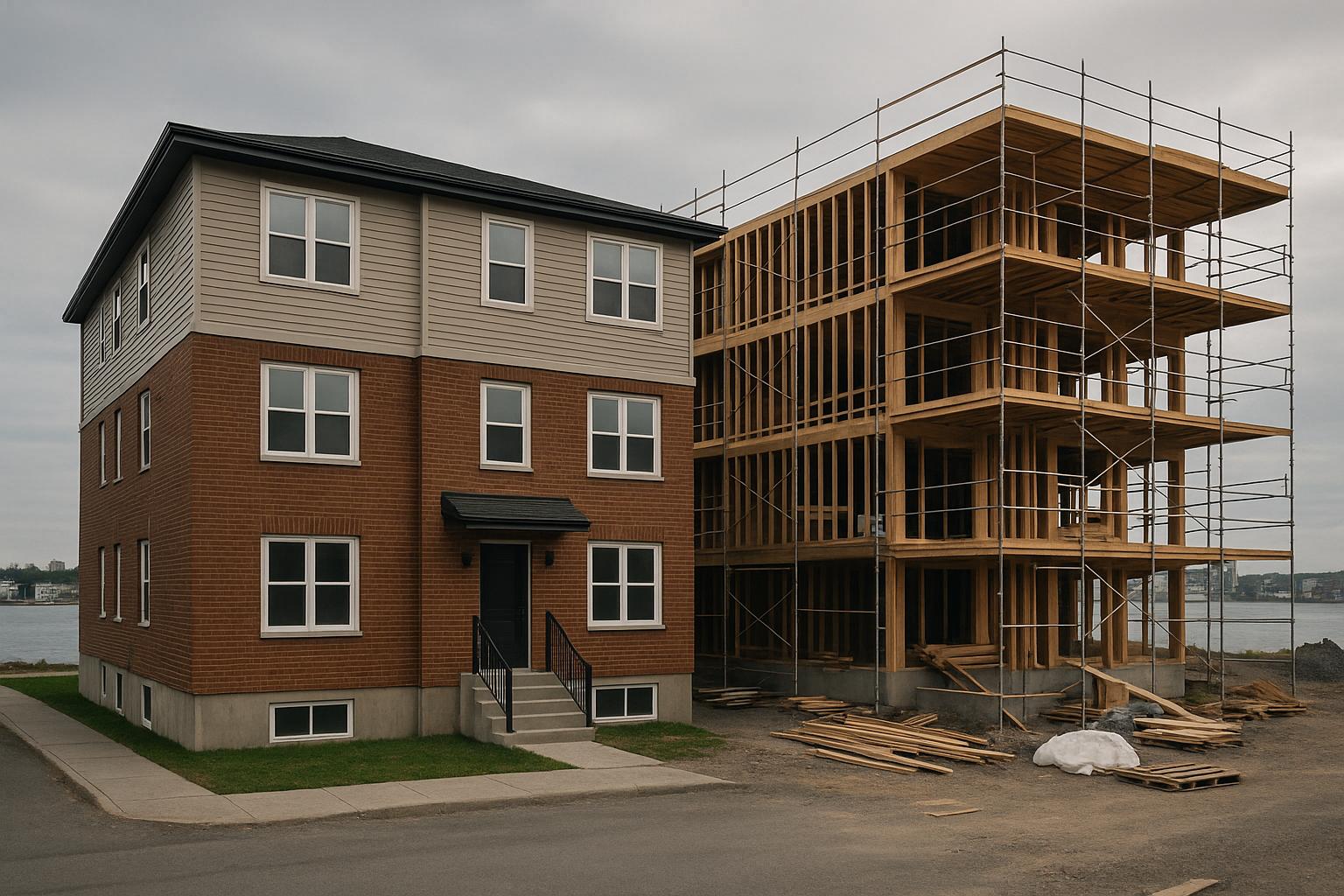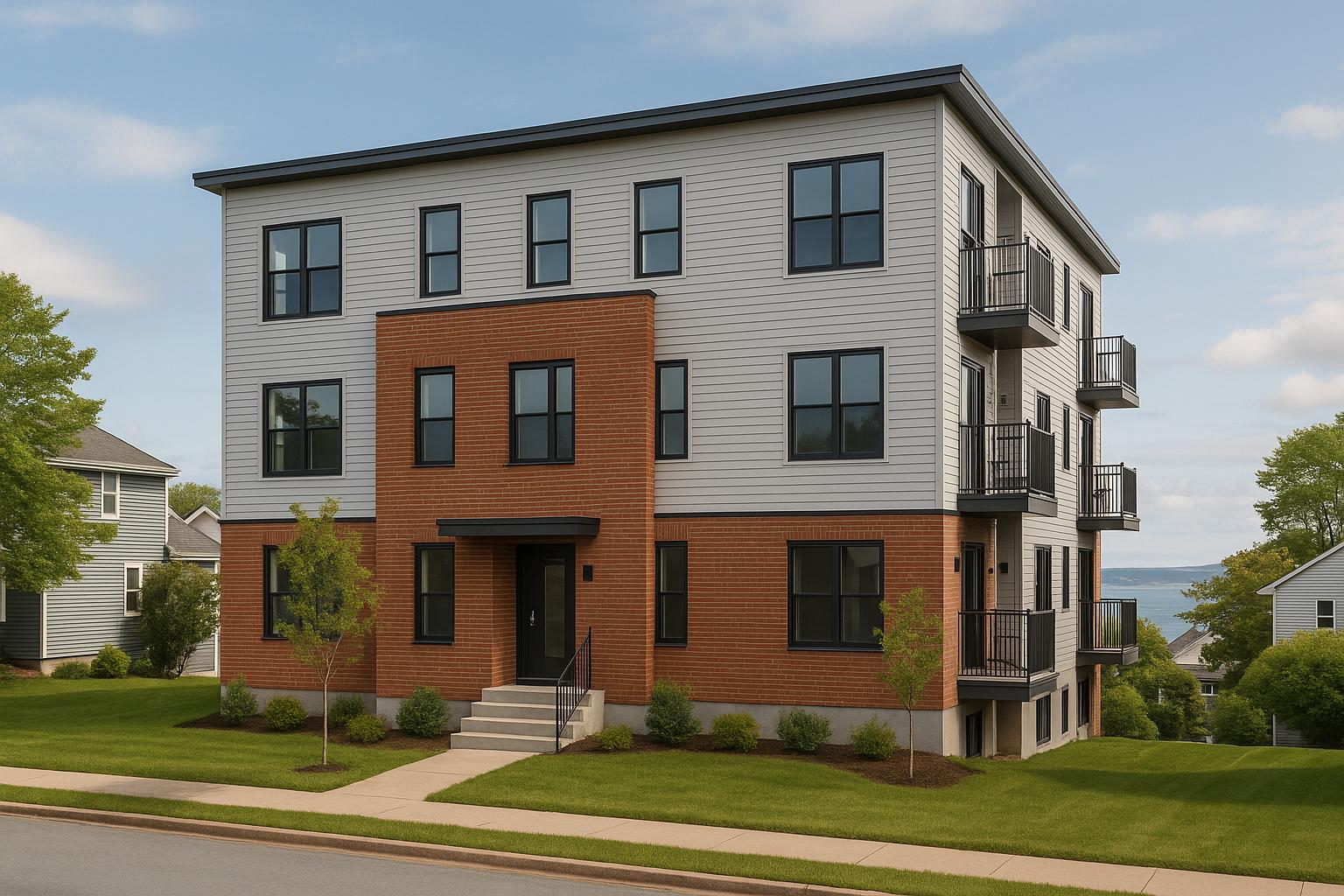Building during Nova Scotia’s winter months is not only possible but can be efficient and cost-effective with the right approach. Despite challenges like freezing temperatures, heavy snowfall, and strong winds, advancements in construction methods and materials make winter projects manageable. Here’s what you need to know:
- Winter Conditions: Temperatures range from -5°C to -20°C, with frequent freeze-thaw cycles and up to 200 cm of snowfall in some areas.
- Key Challenges: Cold weather impacts materials (e.g., concrete curing, wood brittleness) and worker productivity, while snow and ice can delay site access and increase safety risks.
- Solutions: Techniques like heated enclosures, prefabricated components, and cold-weather additives ensure materials perform well. Proper site management, such as covered storage and timely deliveries, minimizes delays.
- Integrated Builders: Using a single team for design and construction simplifies coordination, reduces delays, and ensures fixed costs and timelines.
- Cost and Timelines: Winter construction often costs less due to off-season discounts, with fixed-price models ($160,000 per unit) and six-month completion guarantees protecting budgets and rental income.
Winter construction can be a practical choice if managed well, offering predictable outcomes and reliable timelines for multi-unit rental properties.
Winter Construction Challenges in Nova Scotia
Weather Problems
Winters in Nova Scotia bring a unique set of challenges that demand careful planning. The combination of extreme cold and fluctuating temperatures can affect materials and force adjustments in construction methods. Heavy snowfall often blocks access to construction sites, making it harder to deliver equipment and supplies. Coastal winds during storms can make certain tasks - like crane operations or roofing - too dangerous to carry out. Ice formation on surfaces adds another layer of risk, increasing the likelihood of accidents and delaying progress. Without proper coordination, these factors can stretch timelines and inflate costs.
The harsh weather also impacts how materials perform, as explained below.
Material Issues in Cold Weather
Cold temperatures can significantly affect the behaviour of construction materials, making preparation essential. For example, concrete takes longer to cure in low temperatures, and without special additives, it may not reach its full strength. Storing materials properly becomes more complicated in winter too. Lumber can become brittle, adhesives and sealants might fail to set correctly, and insulation can absorb moisture, reducing its effectiveness.
Interior finishing tasks like painting or applying drywall compounds also require controlled environments. In unheated spaces, work might need to pause until conditions are more favourable. Winter weather can also disrupt supply chains - delays in deliveries or materials damaged by exposure to cold and moisture are common issues. This makes proper storage and planning critical to keeping projects on track.
The impact of winter conditions doesn’t stop at materials; it also affects the people doing the work.
Worker Productivity and Safety
Winter construction doesn’t just challenge materials - it takes a toll on workers too. Shorter daylight hours and the need for frequent warming breaks cut into productivity. On top of that, heavy winter clothing and gloves can make it difficult to perform detailed tasks, slowing down progress.
Cold weather also affects equipment. Batteries drain faster, and tools often don’t work as efficiently. If these issues aren’t managed well, delays and increased labour costs can quickly pile up.
These combined challenges underscore the importance of a well-organized, systematic approach to winter construction in Nova Scotia. Proper planning and coordination are key to overcoming the obstacles posed by harsh winter conditions.
Log Cabin Build 12x16: Front Gable Roof at -14° | Solo Winter Construction Challenge
How Integrated Builders Handle Winter Challenges
Integrated builders take a unified approach to tackle the logistical hurdles of winter construction, turning what might seem like an unpredictable season into a well-organized process.
Integrated vs. Multiple Contractor Approaches
In traditional construction, managing multiple independent contractors becomes a juggling act, especially when winter weather throws a wrench into the schedule. For instance, a snowstorm that delays concrete pouring can trigger a domino effect: the general contractor scrambles to contact the supplier, architects might need to revise plans, and subcontractors have to shuffle their schedules. This fragmented approach often leads to significant delays during winter months.
Integrated builders, on the other hand, streamline the process by housing all professionals under one roof. Instead of property owners managing multiple contracts and dealing with blame games when weather disrupts plans, a single company oversees everything from design to completion. This setup allows the team to respond quickly to changing conditions, avoiding the delays that come with coordinating separate businesses.
The difference is especially noticeable in winter. While traditional builders may spend days rescheduling contractors after a storm, integrated builders adjust immediately because the entire team operates as one cohesive unit. This approach eliminates the need to wait for one contractor to finish before another can start and avoids disputes over responsibilities. The result? Better control over both costs and timelines.
Fixed Timelines and Costs
Winter construction often comes with concerns about unexpected expenses and extended timelines. Cost-plus contracts, commonly used in traditional methods, can leave property owners vulnerable to unplanned costs, such as extra heating or special material handling, with little transparency.
Integrated builders like Helio address these concerns with a fixed-price model of $160,000 per unit and a firm six-month completion guarantee. Regardless of winter challenges, property owners know exactly what they’ll pay and when their project will be ready. To back this promise, Helio offers financial penalties of up to $1,000 per day if construction runs over schedule.
This fixed-price model works because integrated builders factor winter conditions into their planning from the outset. By managing the entire process, they can build weather contingencies into both the timeline and the budget. Property owners avoid the 30–60% budget overruns that are all too common in traditional winter projects.
The guarantee also protects property owners from revenue losses caused by delays. For example, a fourplex expected to generate $8,000 per month in rent could lose a significant amount if construction is delayed by even a single month. With fixed timelines and financial penalties in place, integrated builders have strong incentives to deliver on time, no matter the weather.
Advanced Scheduling and Daily Updates
In addition to fixed pricing and coordinated teams, advanced scheduling tools further streamline winter construction projects. Cold-weather building demands more precise planning than fair-weather projects, and traditional scheduling methods often fail to account for the variability of winter conditions.
Integrated builders use advanced scheduling systems that incorporate historical weather data and provide daily progress updates through a project portal. These tools consider Nova Scotia’s winter patterns, material delivery challenges, and the specific needs of each construction phase. This proactive planning minimizes surprises and keeps projects on track.
Daily photo updates enhance transparency, giving property owners real-time insights into their project’s progress. Through the project portal, owners can monitor their investment from anywhere, alleviating the uncertainty that often accompanies winter construction.
This level of coordination is especially critical for weather-sensitive tasks. While traditional builders might have crews working on conflicting schedules during a delay, integrated builders ensure all trades operate in sync. By addressing weather-related challenges head-on, they transform winter construction into a predictable and efficient process.
Thanks to this systematic approach, property owners can feel confident that their projects will stay on schedule, even during Nova Scotia’s harsh winter months. Advanced planning, combined with financial guarantees, turns winter construction into a manageable and transparent endeavour.
sbb-itb-16b8a48
Methods for Winter Construction
Building during the winter months in Nova Scotia requires a thoughtful approach to handle the challenges of cold weather. By using specific techniques and strategies, construction projects can stay on track despite the harsh conditions.
Construction Methods for Winter
Temporary enclosures are a game-changer for winter construction. By using heavy-duty tarps, scaffolding, and propane or electric heaters, these enclosures create a controlled and heated workspace, shielding workers and materials from the elements.
For concrete work, Insulating Concrete Forms (ICF) are a smart choice. These forms provide built-in insulation, helping concrete cure properly while reducing the need for additional heating. When pouring foundations, techniques like using concrete additives (such as calcium chloride), warmed water, and preheated aggregates can speed up curing times and protect against freezing.
Adjusting work schedules is another practical solution. Starting projects early in the day and wrapping up by mid-afternoon allows teams to make the most of limited daylight, improving both productivity and safety.
These methods are the foundation for effective material and site management during winter construction.
Material and Site Management
Proper material and site management are essential to keep winter projects running smoothly. Covered storage areas shield supplies from snow, moisture, and the freeze-thaw cycle that can cause damage. For instance, lumber can be stored in heated containers or under temporary shelters equipped with dehumidifiers to maintain stable conditions.
Scheduling timely deliveries is another key strategy. It minimizes the exposure of materials to the elements, reducing the risk of degradation. On-site, clear pathways for equipment and materials are crucial. Regular snow and ice removal, along with heated walkways or cables, ensures safe and efficient movement. Effective drainage systems are also critical to prevent ice buildup, which could pose risks to both workers and the structure.
Winterizing equipment is equally important. Using winter-grade fluids, engine block heaters, and storing battery-operated tools in warm areas ensures machinery stays operational in low temperatures.
Good site management also supports the use of prefabricated components, which can significantly reduce weather-related delays.
Using Prefabricated Components
Prefabrication is a practical solution for winter construction, as it minimizes on-site exposure to bad weather. Structural elements like wall panels and roof trusses are built in controlled, heated facilities, then delivered to the site for quick assembly, saving time and reducing weather-related interruptions.
Pre-built modular assemblies, such as bathrooms or kitchens, bring additional efficiency. These units, complete with plumbing, electrical systems, and finishes, are constructed in climate-controlled environments and installed on-site as finished pieces. This approach streamlines the process and keeps interior work on schedule.
Similarly, pre-hung doors and windows with factory-applied weatherstripping allow for faster enclosure of the building, enabling interior work to progress without lengthy adjustments. Engineered lumber products, like laminated veneer lumber (LVL) and engineered joists, are also ideal for winter use. Their stable moisture content and dimensional reliability ensure consistent performance, even in fluctuating temperatures.
The success of prefabrication hinges on precise coordination. Advanced scheduling systems help track production and ensure components arrive at the right time. This level of planning is especially critical in winter, where opportunities for outdoor work may be limited by weather conditions.
Winter Build Costs, Timelines, and Quality
Building during the winter months offers distinct advantages in terms of cost, timelines, and quality for multi-unit rental properties. Compared to the busier summer season, winter construction provides more predictable outcomes and better value.
Winter vs Summer Construction Costs
Construction during Nova Scotia's off-peak months (October to March) can save property owners money. With lower demand for materials and services, suppliers often offer discounts. For example, window manufacturers provide winter booking deals, and lumber prices tend to drop during these months [1][2]. This creates a buyer's market, allowing property owners to secure better prices.
"The winter discounts should more than offset the additional costs of frost protection, concrete additives, and heating." – Keith Sawlor, Second Generation Owner, Sawlor Built Homes [1]
In contrast, summer construction often comes with higher material costs and scheduling headaches. The peak season means contractors are busier, leading to backlogs and potential delays. This increased competition for trades and materials can drive up expenses [2].
"The winter months are usually when building materials and construction costs are lowest due to less demand." – APOLLO Insurance [2]
To further manage costs, fixed-price models are often used, absorbing seasonal price variations and providing budget certainty. Combined with predictable timelines, this approach makes winter construction a financially sound choice.
Timeline Guarantees and Returns
For rental property owners, sticking to a timeline is essential since delays can directly impact rental income. Traditional construction methods often stretch project durations, but a six-month completion guarantee ensures timely delivery. This guarantee includes penalties of up to $1,000 per day for delays, protecting owners from unexpected setbacks.
Starting construction in October or November allows projects to finish by March or April, just in time for the peak rental season. Using an integrated construction process, advanced scheduling, and daily updates, these projects maintain transparency and stay on track, even in challenging winter conditions. This systematic approach ensures owners can begin earning rental income as planned.
Quality Control in Winter
Winter construction doesn’t mean sacrificing quality. A rigorous triple-verification process ensures high standards. A professional engineer inspects five critical stages of the build, and property owners have the final say by choosing the last inspector. This process guarantees that weather conditions don’t compromise the outcomes.
Builders also adhere to strict energy-efficient standards. Components like triple-pane windows and advanced insulation systems are checked to ensure they meet specifications. Two-year warranties on all work provide further assurance of quality.
Daily photo updates allow property owners to monitor progress remotely, ensuring transparency and accountability throughout the project.
Conclusion: Winter Construction Benefits
Main Points
Winter construction in Nova Scotia brings specific advantages for multi-unit properties, especially when using an integrated design-build approach. With a fixed-price model of $160,000 per unit and a guaranteed 6-month timeline, property owners can count on predictable costs and schedules. Quality is assured through a triple-verification process, which includes professional engineer inspections and a 2-year warranty. On top of that, rental income of $1,950–$2,100 per unit per month and an annual ROI of 12–20% highlight the strong financial potential.
Selecting the Right Builder
To fully capitalize on these benefits, choosing the right builder is essential. Winter construction's success hinges on working with a builder who has integrated capabilities and a proven track record in cold-weather projects. Unlike traditional methods - where fragmented teams often face miscommunication and delays - an integrated builder handles design, engineering, and construction as a unified process.
Helio Urban Development stands out as a leader in this space. As Nova Scotia's only integrated design-build firm specializing in 4+ unit rental properties, Helio streamlines every phase of the project. Their fixed-price model guarantees completion within six months, with penalties of up to $1,000 per day for delays, ensuring accountability.
Helio also uses advanced scheduling tools and provides daily photo updates, allowing property owners to track progress in real time, regardless of weather conditions. This system prevents budget overruns, which can often inflate costs by 30–60% with fragmented approaches, while maintaining a strong focus on quality.
For property owners thinking about winter construction, the real question isn’t whether to build in the colder months but which builder can deliver dependable results no matter the season. With an integrated approach, winter construction challenges can become opportunities, offering reliability and efficiency year-round.
FAQs
What are the benefits of building multi-unit rental properties in Nova Scotia during the winter months?
Building multi-unit rental properties during the winter in Nova Scotia comes with some clear perks. For starters, lower demand in the off-season often means reduced costs for both materials and labour. On top of that, permit approvals might move faster, helping to keep your project on schedule.
Thanks to modern construction techniques, like advanced wood-frame methods, building in colder temperatures isn't a problem. These approaches allow work to continue smoothly without compromising quality. Together, these benefits make winter an efficient and budget-friendly time to take on construction projects while still meeting deadlines and ensuring long-lasting results.
How can integrated builders guarantee fixed costs and timelines for winter construction in Nova Scotia, and what are the advantages?
Integrated builders manage to maintain fixed costs and stick to timelines for winter construction by combining careful planning, advanced building methods, and modern materials. For instance, using insulated concrete forms (ICFs) and prefabricated components helps minimise delays caused by weather, keeping projects on track and within budget.
This method comes with key benefits like predictable costs, fewer surprises in scheduling, and dependable results. By adopting these techniques, construction projects can move forward seamlessly, even during Nova Scotia's chilly winter months, offering property owners confidence and timely completion.
How can material performance and worker safety be managed during winter construction in Nova Scotia?
Managing construction projects during Nova Scotia's harsh winters requires careful planning and proactive strategies to ensure both material integrity and worker safety.
To safeguard materials, insulated coverings and weatherproof storage solutions are commonly employed. These measures help prevent freezing and moisture damage, which can compromise the quality of construction materials. Additionally, critical tasks are often scheduled during periods of milder weather to minimise risks associated with extreme cold.
When it comes to worker safety, the focus shifts to combating the dangers of cold stress, hypothermia, and frostbite. This is achieved through heated shelters, appropriate layered clothing, and regular health checks. These precautions not only protect workers but also ensure projects can continue without compromising safety or quality, even in the face of challenging winter conditions.



